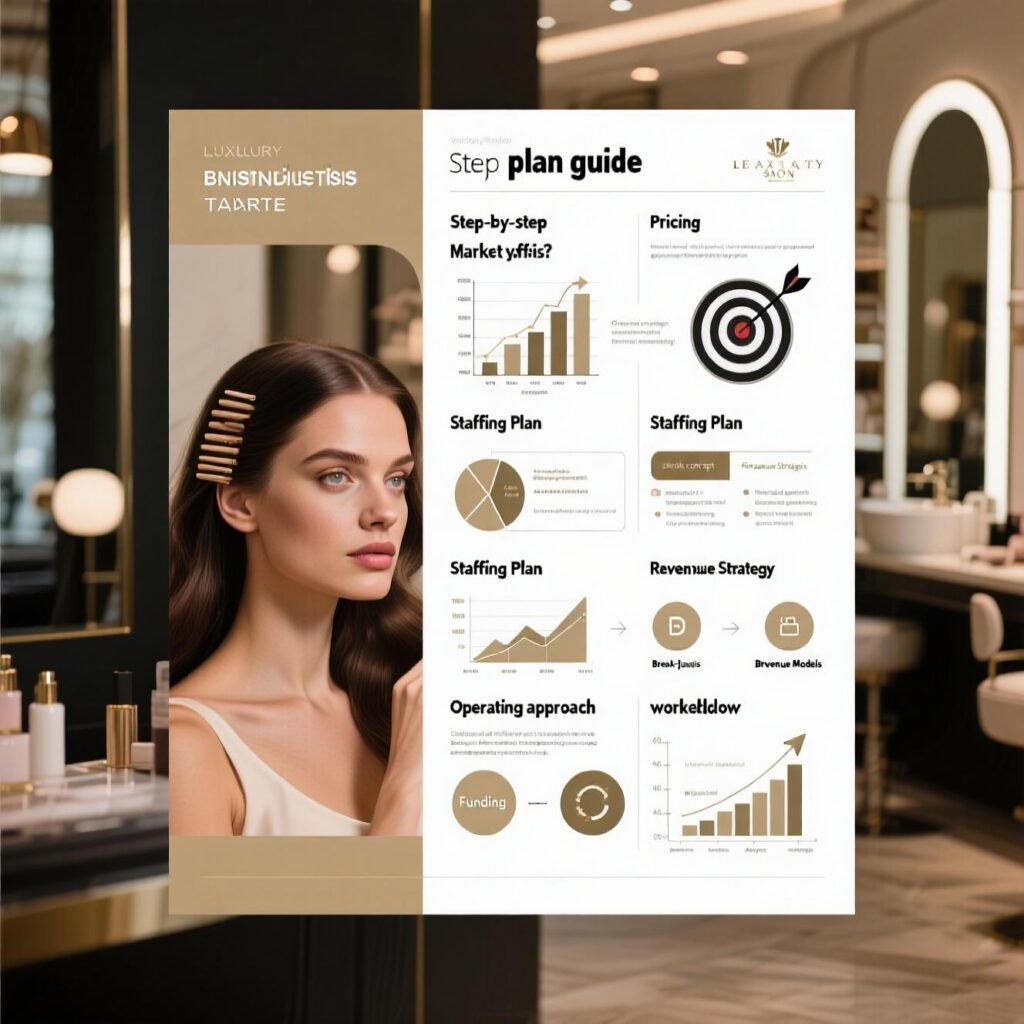How do I create a business plan for a hair and beauty salon?

Content
How do I create a comprehensive business plan for a hair and beauty salon, including a detailed market analysis of my target demographic in [specific location], projected startup and operating costs, revenue forecasting based on service packages, staffing and training protocols, inventory management for professional products, marketing strategies (both digital and local), legal structure considerations, and contingency plans for challenges like client retention and seasonal fluctuations? Also, what key metrics should I include to track financial performance and growth milestones post-launch?
Creating a business plan for a hair and beauty salon involves a structured approach covering key operational, financial, and strategic elements. Below is a comprehensive outline with detailed steps for each section:
1. Executive Summary
- Mission Statement: Define your salon’s core purpose (e.g., “To provide premium, eco-friendly hair and beauty services in a luxurious, inclusive environment”).
- Vision Statement: Long-term goals (e.g., “Become the top-rated salon in [City] within 5 years”).
- Business Concept: Describe services (e.g., hairstyling, coloring, facials, manicures), target market (e.g., professionals, families, luxury-seeking clients), and unique selling points (e.g., organic products, gender-neutral services).
- Financial Highlights: Summarize startup costs, projected revenue, and profitability timeline.
- Ownership Structure: Legal entity (e.g., sole proprietorship, LLC) and key personnel.
2. Company Description
- Business Name, Location, and History: Proposed name, address (or desired area), and background of founders if applicable.
- Legal Structure: Explain the chosen entity and compliance with licensing/permits (e.g., cosmetology board approvals, health department certificates).
- Objectives:
- Short-term: “Achieve 80% capacity in 6 months.”
- Long-term: “Expand to 3 locations by Year 3.”
- Values: Commitment to sustainability, customer service, or community involvement.
3. Market Analysis
- Industry Overview: Cite market size (e.g., U.S. beauty industry revenue: $64B/year) and trends (e.g., demand for sustainable products, wellness services).
- Target Market:
- Demographics: Age, income, location (e.g., urban professionals aged 25–55).
- Psychographics: Values (e.g., eco-consciousness), preferences (e.g., minimalist styles).
- Competitor Analysis: List 5–10 local competitors. Rate their strengths (e.g., “Competitor X has a loyal following due to discounted packages”) and weaknesses (e.g., “Competitor Y lacks online booking”).
4. Organization and Management
- Management Team: Roles/responsibilities (e.g., Salon Manager, Lead Stylist, Marketing Lead) with bios highlighting experience.
- Staffing Plan:
- Full-time/Part-time Roles: Stylists, estheticians, receptionists, nail technicians.
- Hiring Timeline: “Hire 2 senior stylists and 1 junior stylist pre-launch.”
- Legal/Advisory Support: Accountant, lawyer, or business coach.
5. Services and Pricing
- Service Menu:
- Hair: Cuts, coloring, extensions, keratin treatments.
- Beauty: Facials, waxing, makeup, manicures/pedicures.
- Add-ons: Retail products (brand merchandise), packages (e.g., “Bridal Prep Bundle”).
- Pricing Strategy:
- Tiered pricing (e.g., Junior Stylist: $45/cut; Master Stylist: $80/cut).
- Student discounts, loyalty programs, or membership subscriptions.
- Product Sourcing: Suppliers for high-quality, ethically sourced products (e.g., Davines, Aveda).
6. Marketing and Sales Strategy
- Brand Identity: Logo, color scheme, and ambiance (e.g., modern minimalist with biophilic design).
- Sales Channels:
- Local: Walk-ins, partnerships with bridal boutiques.
- Digital: Website, social media (Instagram, TikTok), email marketing.
- Promotions: Grand opening discounts (e.g., 30% off first visit), referral rewards, and seasonal offers (e.g., Summer Hair Color Special).
- Online Presence: SEO-optimized website, Google My Business profile, and booking software (e.g., Vagaro, Fresha).
7. Financial Projections
- Startup Costs:
- Rent/Deposits: $10,000.
- Equipment: $15,000 (styling chairs, wash units, skincare device).
- Initial Inventory: $5,000.
- Marketing: $2,000.
- Licenses/Insurance: $1,500.
- Revenue Forecast:
- Year 1: $200,000 (based on 30 clients/day at $150 average).
- Year 2: $300,000 (15% growth).
- Year 3: $450,000.
- Profit and Loss (P&L) Statement: Project monthly costs (salaries, utilities, supplies) and net profit (aim for 15–25% margin).
- Break-Even Analysis: Calculate when revenue covers costs (e.g., “Break even by Month 8”).
- Funding Request: If seeking loans/investors, specify amount and use of funds.
8. Appendix
- Permits, licenses, or patents.
- Resumes of key staff.
- Market research data.
- Floor plan layout (e.g., 1,200 sq. ft. with 5 styling stations, 2 wash basins, waiting area).
- Supplier contracts and pricing quotes.
Final Tips:
- Visually: Include graphs/charts in projections.
- Updates: Review the plan quarterly to adapt to market changes.
- Compliance: Ensure alignment with local health/safety regulations (e.g., sanitation protocols).
This framework delivers a actionable roadmap for launching and scaling a hair and beauty salon.
